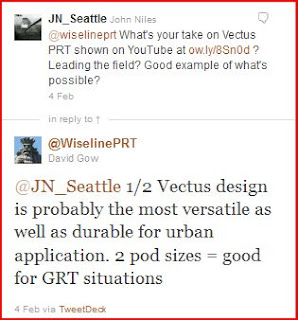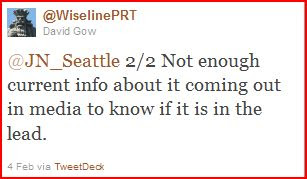One of the most useful things to know when playing defense against
Ken Avidor is that his playbook only has a few pages. He has four basic
moves:
The Cherrypick. This is where he only uses facts favorable to his
claims, discarding the rest. Examples: repeating 'Bachmann's PRT
boondoggle' while ignoring the 13 Democrats who supported PRT in the
Minnesota Senate; blaming a Minnesota High Speed Rail Commissioner's separate support of PRT for cancellation of Ohio and Wisconsin HSR, ignoring that Governors Kasich and Walker just want President Obama to fail.
Far And Away. He lies about places he thinks would be difficult to
verify. Blaming a few years of PRT planning for over a decade of
neighborhood decay in England is an example of Far And Away.
Others include: claiming to be from Alameda; depicting PRT in locations
where no one is proposing putting it (1, 2); making a big deal about Amritsar merchants protesting pod transit with a dharna fast, when dharnas are actually very common in
India.
Hail Mary. This is when Ken says something prima facie wrong, or a misquote,
and hopes to get away with it. Examples: A PRT system for one city
"would be in the trillions of dollars"; a dropped sentence fragment
turns an anti-oil tweet into a pro-Keystone pipeline tweet.
The Hidden Ball Trick. He states something as fact, tries to camouflage
it with bluster or under a layer of narrative, and hopes no one
factchecks it.
What is great -- I count on it -- is that Ken runs these same plays over and over even though they never work.
One of the earliest examples of Hidden Ball was 7 years ago. Read this
2005, pre-
PRT Is A Joke IS A JOKE writeup at the NewsCenter, "
See How They Distort". In it we took
apart
Ken's phony claim:
Taxi 2000 Document Reveals Safety Concerns Can Make PRT Systems "Unworkable".
...The following are excerpts that show that Taxi 2000 itself believes that PRT is a very risky investment.
"Federal and State safety regulation of automated transit systems can
make PRT systems unworkable. Since there are no examples of our
technology currently in operation, we cannot predict what sort of state
or federal government safety regulation might apply. At this
juncture, the Federal Transit Administration - which would exercise
whatever regulation might apply at this level - has left the matter
up to the states. Management believes the states will look foremost to
the work of a committee of the American Society of Civil Engineers,
which has developed a set of safety standards for "Automated People
Movers" (APM's). We have been following that work and think at this
point it will pose only one problem: eg., "brick wall stopping"
requirements for the control system (borrowed from railroad signaling
practice). The requirement is that if one vehicle stops instantaneously,
the next vehicle must be able to stop before hitting the stopped one.
That requirement would inhibit the sort of minimum vehicle headway
used in our design, but it would not affect operation of the first,
lower density systems. In the context of PRT, "headway" means the
nose-to-nose time spacing between two sequential vehicles. Setting a
minimum allowable headway determines the maximum carrying capacity of
the guideway. We will work to have the headway requirement amended,
since we believe it is inappropriate to PRT technology, but there is no
guarantee we will be successful in that regard.
...The above paragraph is not some earth-shaking secret admission of a
fatal flaw. In fact it is a fairly standard "safe harbor"
statement, something all companies that offer stock are
required to do, to apprise prospective investors of every conceivable
risk, no matter how remote...
Every public company has safe harbor statements in their prospectuses,
annual reports and 10-K filings. So if everyone gave full, literal and
equal weight to everything in safe harbors, no one would ever
invest in anything.
It's as if
Ken thought no one would think to look up
"risk factors" investment on the
Internet and see there are over 25 million hits.
Return of the Hidden Ball
So when
Ken Avidor posted this yesterday at The PRT Moondoggie blog, I immediately recognized the play:
...Here the "Business Plan" includes the lengthy bios of J. Edward
Anderson, A. Scheffer Lang and Raymond A. MacDonald. Then it gets around
to... the money:
The Taxi 2000 business plan requires funding of twenty-five million
dollars to be raised in successive rounds over a thirty-six month
period. The funds will be used for completing specifications, building
of the test track facilities, world-class procurement and marketing.
Exit Strategy
The opportunity for investor exit should occur between months 54 and 72.
At this juncture, Taxi 2000 should have a strong backlog of booked
sales, as well as a substantial number of highly interested potential
customers. Initial system installations should be complete and
operating, with other systems under construction.
Two potential opportunities for investor exit will be an IPO or a
strategic acquisition by a large corporate interest. The strategic
acquisition of the investor position would be the more likely scenario
but this would be determined by the climate of the public equity markets
at that time.
The firm has raised $2 million in a $24 million fund-raising effort to
pay for the testing facility and other corporate needs, according to SEC
filings and city documents.
This is a variation of Hidden Ball I call The Smathers, after the
possibly apocryphal story of the politician who smeared Sen. Claude Pepper by
relying on the audience not knowing the meaning of words:
Are you aware that Claude Pepper is known all over Washington as a
shameless extrovert? Not only that, but this man is reliably reported to
practice nepotism with his sister-in-law, he has a brother who is a
known homo sapiens, and he has a sister who was once a thespian in
wicked New York. Worst of all, it is an established fact that Mr.
Pepper, before his marriage, habitually practiced celibacy.
The story here isn't the Taxi 2000 business plan decennial, Avidor is keying on the words "Exit Strategy."
Avidor's oldest talking point is that PRT is a scam, a taxpayer ripoff. So even though he is on record as saying
"If those people want to pursue PRT with their own money, that's okay with me"
here he is calling attention to "the money," the search for investors, and to "Exit Strategy," to distort the meaning of "Exit Strategy" in order to make it sound suspect.
I get
Ken's subtext in full, he means: Taxi 2000 planned to get taxpayer
dollars to build a PRT system, and the original private investors would
cash out and run, leaving the public holding The Bag.
It's as if
Ken thinks anyone couldn't just Google
investor exit strategy definition
and get over 62 million hits, such as:
The Exit Strategy - Strategies for Investor Exit
The majority of Business investors will be looking for a planned exit
strategy worked out at the time of investment. It will be very
beneficial to work out the ideal exit strategy for potential investors
before you seek funding. Investors will need to know when they can
realise a return on investment so this is a crucial area of the pitch to
get right.
Investors want a maximum return on initial investment and a well thought-out exit strategy provides them with the incentive to invest in your venture.
That is to say, investors in startups want to know when they'll realize a return on
investment -- which, like it or not (and I don't really), is the whole
point of venture capitalism as now practiced.
What we know: Every 'good' startup business plan includes an investor exit strategy.
Therefore when
Ken Avidor writes “Interesting - a
business plan with an "Exit Strategy"?” his interior monologue is screaming,
'Don't bother reading this, because I am an ignoramus. I don't know what I'm talking about. I really just
don't know.'














 +
+ +
+















